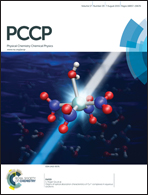Hindered rotational physisorption states of H2 on Ag(111) surfaces
Abstract
We have investigated the physisorption states of H2 on Ag(111) surfaces. To clarify the accurate adsorption properties of H2 on Ag(111), we performed first-principles calculations based on spin-polarized density functional theory (DFT) with the semiempirical DFT-D2 method and the newly-developed exchange functional with the non-local correlation functional vdW-DF2 (rev-vdW-DF2). We constructed exhaustive potential energy surfaces, and revealed that non-negligible out-of-plane potential anisotropy with a perpendicular orientation preference exists even for H2 physisorption on planar Ag(111), as predicted by previous results of resonance-enhanced multiphoton ionization spectroscopy and temperature-programmed desorption experiments. Therefore, the molecular rotational ground states of ortho-H2 split into two energy levels in the anisotropic potential. The obtained adsorption energy and the number of bound states, including the zero-point energies and the rotational energy shift, agree with diffractive and rotationally mediated selective adsorption scattering resonance measurements. The origin of the potential anisotropy on Ag(111) is a combination of the London dispersion interaction and the virtual transition of the metal electron to the unoccupied molecular state.


 Please wait while we load your content...
Please wait while we load your content...